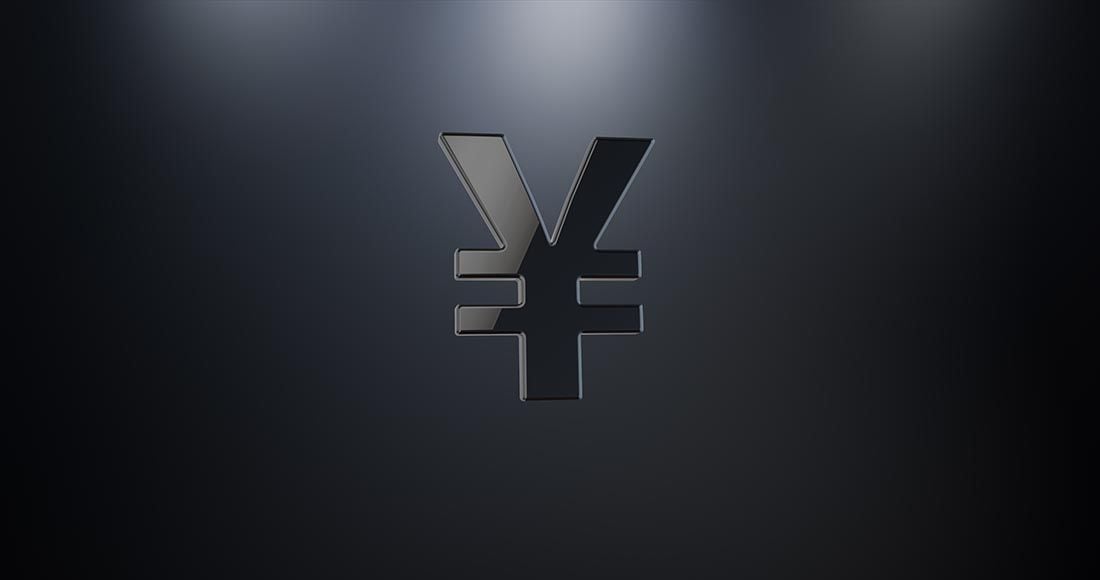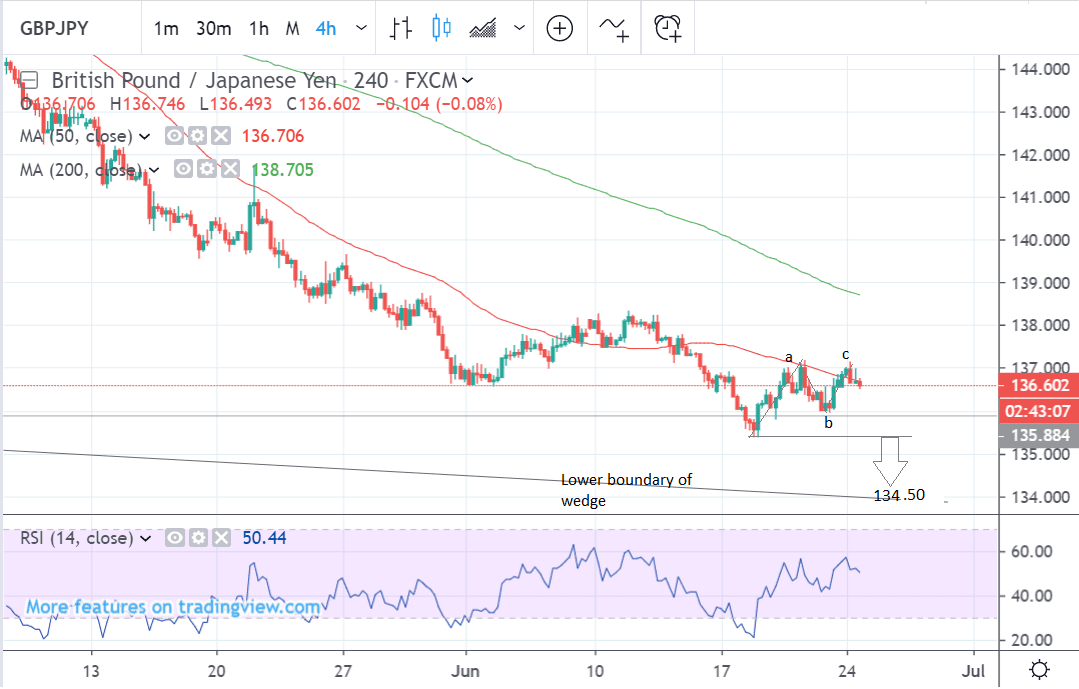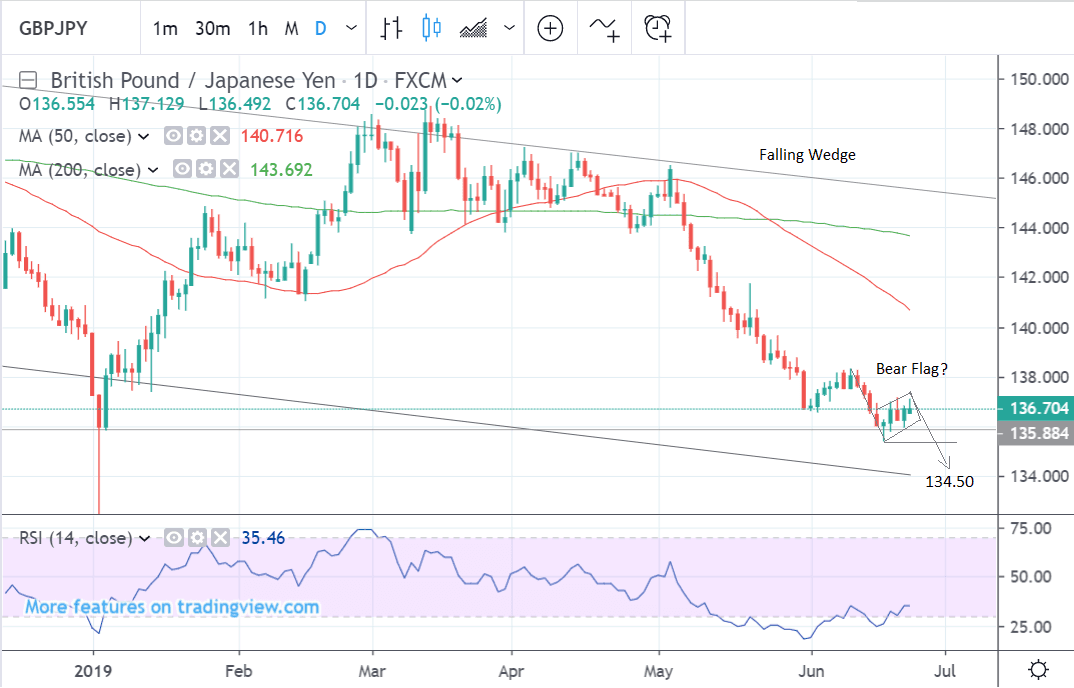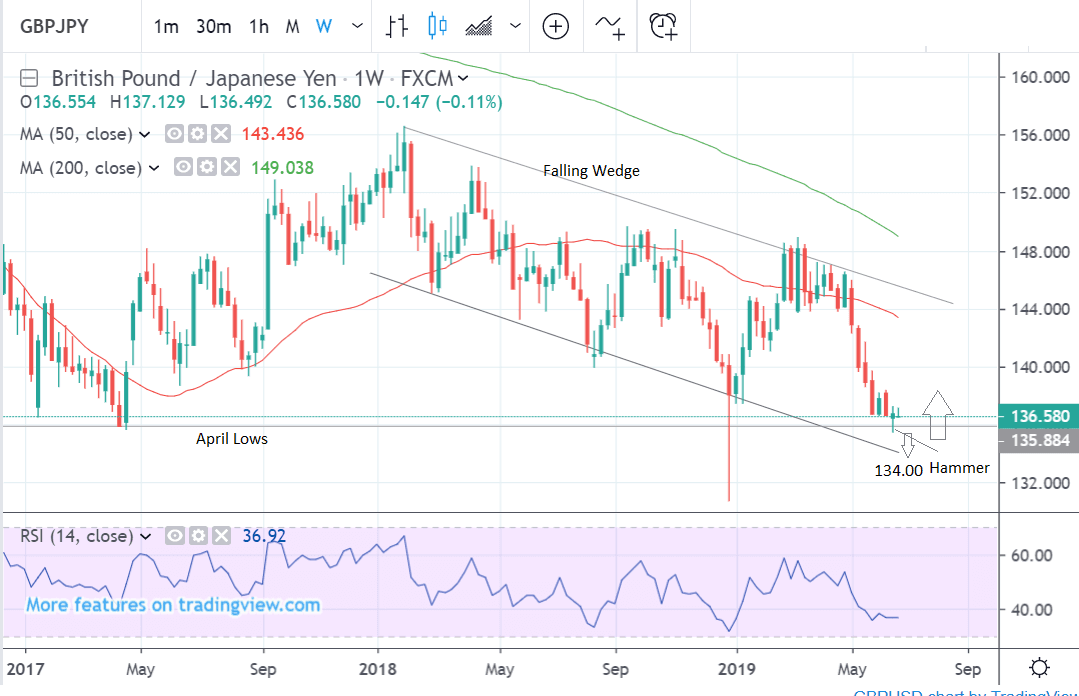Pound-Yen Downtrend Forecast to Continue to Bottom of Wedge

Image © Adobe Stock
- GBP/JPY in established downtrend
- Not far now from bottom of wedge pattern
- Yen to be driven by global risk trends, BOJ minutes
The Pound-to-Yen exchange rate is trading at around 136.60 at the time of writing, marginally up at the start of the week, but studies of the charts suggest the exchange rate is set to continue its broader downtrend in the days to come.
The 4-hour chart shows how the pair has pulled back over recent days in what looks like a three-wave ‘abc’ correction. Such moves are quite common in downtrends and once complete prices usually resume their downtrend.
A break below the 135.38 lows would provide confirmation of a continuation down to a target at 134.50 eventually over the short-term time horizon.
We use the 4 hour chart to give us an indication of the short-term outlook which includes the week ahead.
The daily chart shows how the pair has recovered ever since it based and formed a bullish hammer candlestick at the 135.38 lows on June 18.
The relative lack of bullish momentum, however, is a sign the downtrend will probably resume. In fact, the pair looks like it has formed a bearish flag pattern. This happens when the pair falls steeply and then consolidates in a roughly sideways move. The steep fall is the ‘pole’ the consolidation is the ‘flag’.
Bear flags usually extend a roughly equal amount as the length of the ‘pole’ extrapolated lower. In this case that suggests an end target of 134.50.
A break below the June 18 lows would provide confirmation.
The RSI momentum indicator is bullish after just exiting oversold, however, on its own this isn't enough to confirm a reversal of the downtrend. Nevertheless, it does caution against getting too bearish.
The daily chart is used to analyse the medium-term outlook which includes the next couple of weeks to a month.
The weekly chart shows how the pair has now nearly reached the lower borderline of a large wedge pattern, which has encompassed activity since the beginning of 2018. The lower border is at about 134.00.
There is a chance that it could fall to and then bounce off the lower borderline and recover, back up inside the wedge.
The pair has already formed a bullish hammer candlestick in price action last week which is a warning sign the trend may be reversing and turning higher.
The downtrend is so entrenched, however, that the default expectation is for a continuation lower, and a break below the June 18 lows would provide confirmation.
We use the weekly chart to give us an idea of the longer-term outlook, which includes the next few months.
Time to move your money? Get 3-5% more currency than your bank would offer by using the services of foreign exchange specialists at RationalFX. A specialist broker can deliver you an exchange rate closer to the real market rate, thereby saving you substantial quantities of currency. Find out more here.
* Advertisement
The Japanese Yen: What to Watch
The main driver of the Yen is global risk appetite because it is a safe-haven currency so when investors grow fearful it rises, likewise when they grow confident it falls.
The Yen has been trading a little softly this week after tensions between Washington and Tehran surprisingly eased off despite the Iranians shooting a U.S. spy drone out of the sky over the Straits of Hormuz.
The G20 summit on June 28-29 is a major event on the horizon for the Yen. Trade war tensions could come to a head at the meeting either for the better or worse.
A deal seems almost impossible given the lack of common ground between the two teams and the current market consensus expectation is for some sort of a diplomatic gesture showing a willingness to continue talks. Anything short of that is likely to increase global risk aversion and appreciate the Yen.
China and the U.S.’s respective red lines make a compromise seem unlikely.
Beijing wants the U.S. to remove all tariffs but given these have helped rebalance the trade deficit between the two countries - an avowed election promise of President Trump - it is never going to happen. Not as long as Trump is in office, anyway.
Another red line is that the Chinese do not want to be pressured into purchasing U.S. exports. They argue U.S. expectations about the Chinese market for U.S. goods needs to be more “realistic”. There is a possibility of more compromise on this issue but given Trump’s America-first policy probably not much - he’s going to want to be seen championing U.S. exports all the way to the 'endzone'.
Finally China is against enshrining trade agreements into domestic law, something the U.S. wants them to do. They have said they will not submit to intrusions on ‘national sovereignty’. On this point Beijing is almost certainly not going to budge.
All-in-all, therefore, markets may be getting overly hopeful about what the G20 can achieve. It is more likely leaders will pose for the photographers, smile and mouth platitudes.
A recent communique from Chinese Vice Commerce Minister Wang Shouwen suggests China is open to reaching a compromise, but obviously, this could also just be rhetoric aimed at making China ‘look’ more reasonable.
Wang said “equality and mutual benefit means the consultations have to happen on an equal basis, the agreement to be reached has to be beneficial for both sides… Meeting each other halfway means both sides have to compromise and make concessions, not just one side.”
On the domestic data front the minutes of the recent Bank of Japan (BOJ) meeting are the main release to watch as they may shed further light on whether the central bank is considering easing policy or not.
If there are hints of more easing it is likely to weigh on the Yen. The minutes are scheduled for release at 00.50 BST on Tuesday, June 25.
Pressure appears to be growing on the BOJ to consider easing policy partly due to the global slowdown but also because the government is planning to increase the sales tax to 10% in October and the BOJ may want to preemptively ease conditions ahead of the event.
When the sales tax was raised from 5% to 8% in 2014 under Shinzo Abe it caused a recession, and the BOJ will be keen to avoid such an outcome this time around.
Inflation remains moribund in the land of the rising sun , falling to only 0.7% in May, from 0.9% in April on a year-on-year basis - further raising the odds of central bank softening.
The heightened expectations of BOJ action may prompt a greater market sensitivity and interest in domestic data, which normally doesn't impact much on the Yen.
Retail sales is the main release in the week ahead and is expected to come out at 1.2% from 0.4% previously when it is released at 00.50 on Thursday, June 27.
Time to move your money? Get 3-5% more currency than your bank would offer by using the services of foreign exchange specialists at RationalFX. A specialist broker can deliver you an exchange rate closer to the real market rate, thereby saving you substantial quantities of currency. Find out more here.
* Advertisement



